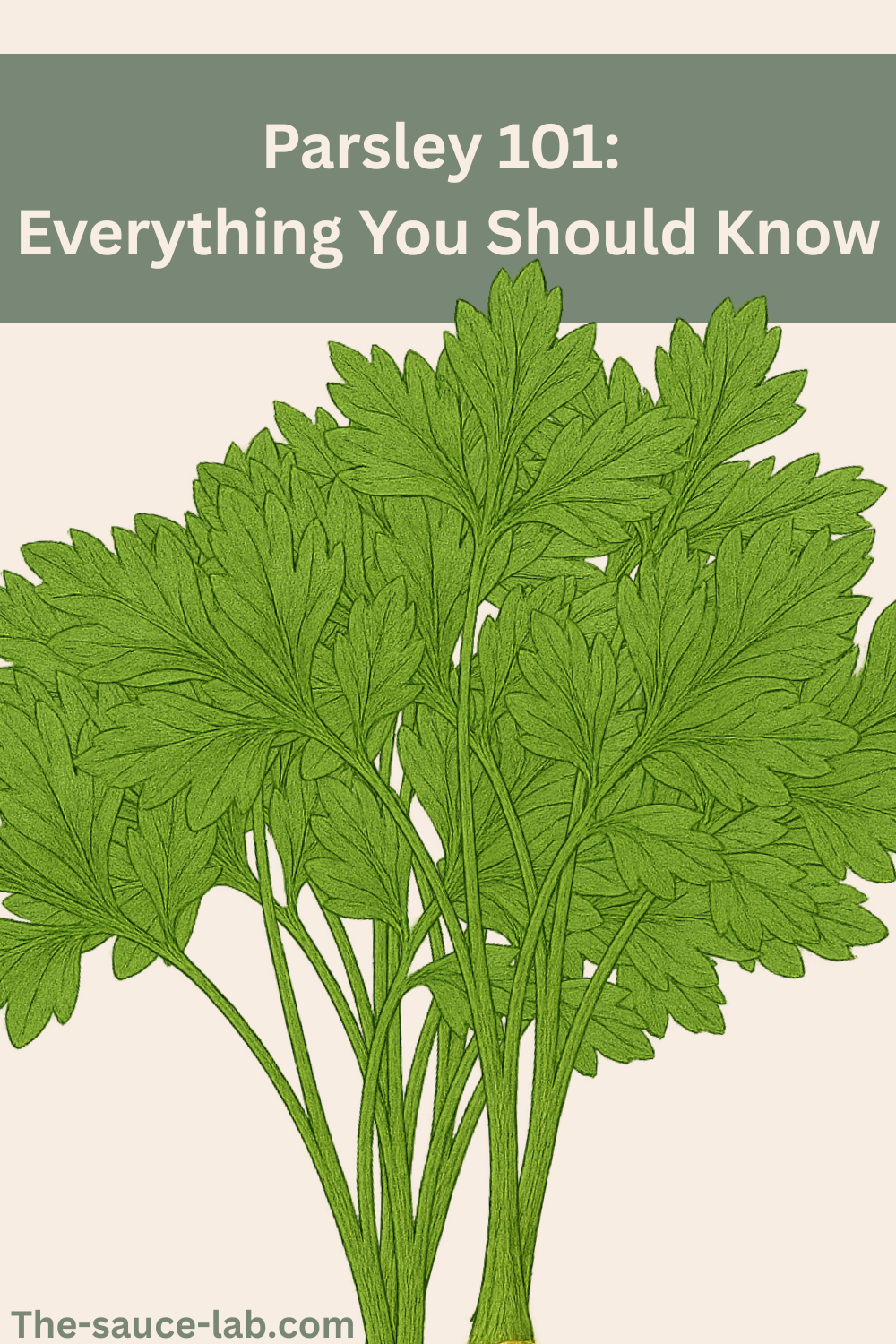Parsley Uncovered: The Herb That Elevates Every Dish

General Information about Parsley
Parsley is one of the most commonly used culinary herbs. It’s a member of the Apiaceae family of plants and is a leafy, herbaceous herb with a bright green colour. It’s a cousin of other well-known herbs and vegetables such as chervil, carrots, celery, dill, coriander, cumin, and so on. It grows abundantly in many regions of Europe, the Eastern Mediterranean, some parts of the Middle East, and the Americas. Parsley occurs in three varieties — flat-leaf or Italian parsley (P. crispum var. neapolitanum), curly (P. crispum var. crispum), used primarily for its leaves, and Hamburg parsley (P. crispum var. tuberosum), which is grown for its edible root (2).
Of note is that there are many other plants called parsley, but they belong to different genera, such as Japanese parsley (Mitsuba) (Cryptotaenia japonica), Chinese parsley / cilantro (Coriandrum sativum), cow parsley (Anthriscus sylvestris), chervil (Anthriscus cerefolium), African parsley (Cymbopogon giganteus or C. citratus), and parsley fern (Cryptogramma crispa) (2).
I highly recommend cultivating your own parsley. The plant is biennial (first-year growth and harvesting, while the second year it reproduces and dies), but it’s often grown as an annual. Both types used for their leaves (curly and flat-leaved) prefer well-drained soil and full sun exposure. If you want to germinate your own seeds, you need to be patient — it germinates slowly.
Culinary Usage of Parsley
Parsley is an herb extensively used in Europe, the Middle East, and the Americas. It is now cultivated globally and used in endless cuisines, including but not limited to French, Greek, Spanish, and Lebanese. The flavour profile of parsley can be described as green and fresh, slightly peppery and bitter, with grassy notes. Those notes pair well with numerous dishes.
In the case of leaf parsley (both curly and flat-leaved), both the leaves and stems can be used. Flat-leaved parsley is used primarily for cooking, while curly parsley is mainly used for garnish because of its appearance. The herb can be used fresh or dried. It’s used in a variety of dishes such as salads, soups, stews, sauces, marinades, and pesto. Most of the time, it is added after cooking in order to preserve its volatile compounds and aroma.
Parsley is a key ingredient in many regional dishes. It is essential for chimichurri, a Latin American sauce containing parsley, oregano, olive oil, vinegar, and chiles used for grilled meat; an essential part of the salad tabbouleh, a Middle Eastern salad made with parsley, bulgur, tomatoes, lemon, and mint. It also contributes to the Italian sauce called gremolata, made with parsley, garlic, and lemon zest, served with osso buco. Back in Europe, it’s one of the main components of bouquet garni used for the preparation of stocks and soups.
Example Dishes Featuring Parsley:
- Chimichurri — Latin American sauce made with parsley, oregano, garlic, olive oil, vinegar, and chiles
- Gremolata — Green sauce made with parsley, lemon zest, and garlic
- Italian Salsa Verde — Herbaceous green sauce traditionally served with meats, fish, or vegetables, made with fresh flat-leaf parsley, garlic, capers, anchovy fillets, olive oil, vinegar or lemon juice, and salt and pepper
- Persillade — A French sauce made with two ingredients: parsley and garlic. Some variations also include oils or butter and other herbs and spices
- Beurre maître d’hôtel — Compound butter made with parsley, butter, lemon juice, salt, and pepper, ideal for steaks, other meats, and vegetables
- Tabbouleh (Levant / Lebanon, Syria, Palestine) — A traditional Middle Eastern salad prepared with parsley, tomato, bulgur, onion, olive oil, lemon juice, and salt
- Maidanosalata (Greek parsley spread) — Greek classic made from parsley, stale bread, onion and garlic, lemon juice, olive oil, balsamic vinegar, and optional egg
- Bouquet garni (parsley, bay leaves, and thyme) — The must-have for preparing strong and delicious stocks and sauces
- Finishing touch for many soups, stews, meat, and fish dishes
Chemical and Functional Properties of Parsley 🧪
Parsley flavour is made up of around 45 volatile compounds, mainly monoterpenes, fatty acid derivatives such as hexanal, (1,3,8)-menthatriene, myristicin, β-phellandrene, apiol, alcohols, aldehydes, and ketones. These, of course, vary among varieties and growing conditions.
Let’s look in more detail at the different compounds and what they contribute to flavour:
- Monoterpenes are the main components of the plant and give it its characteristic aroma.
- Hexanal gives the plant the typical aroma of fresh herbs — a green, grassy note.
- (1,3,8)-Menthatriene gives a parsley-like, woody note and can be found in high-quality, fresh leaves and stems; however, it is lost within minutes after exposure to air or leaf damage.
- Apiol and β-phellandrene also contribute to the “typical parsley” aroma.
- Myristicin adds a spicy note to the plant.
Parsley’s characteristic flavour depends on the ratios of these compounds, which vary from specimen to specimen, and gives either a fresh, aromatic flavour or a dull one. Because of its volatility, parsley is best added at the end of cooking (if using heat) (1,3).
⚠️ Safety Note
No acute or chronic poisoning is observed after ingestion of regular amounts of parsley leaves or roots (as a spice). In very rare cases, parsley can cause allergic reactions. Most often, they occur in people with allergies to other plants from the Apiaceae family (e.g., celery, carrots, etc.) (1).
Biological Activities of Parsley 🧬
Parsley is rich in vitamin C, vitamin K, folate, and antioxidants. Its extracts have different biological activities such as diuretic effect (increases urine production — “pee more”), spasmolytic effect (relaxes muscle spasms), anti-urolithiasis effect (prevents kidney stone formation), hypouricemic effect (reduces uric acid levels), antioxidant effect (protects cells from oxidative damage), anti-inflammatory effect (reduces inflammation), antibacterial effect (fights bacteria), hypolipidemic effect (lowers blood lipids/cholesterol), antihypertensive effect (reduces high blood pressure), antidiabetic activity (helps regulate blood sugar levels), choleretic effect (increases bile secretion — improves digestion), estrogenic activity (mimics or enhances estrogen effects), and antiplatelet effect (prevents blood clots by reducing platelet aggregation) (1,4,5).
Buying Parsley 🌿
- Look for: bright green leaves
- Touch the stems: they should be firm to the touch
- Smell them: they should be fresh and grassy
- Freshness tip: good parsley has a sharp, lemony aroma
- Try to avoid dark, yellow leaves with an earthy smell
- Which one to choose: If you want a stronger flavour, choose flat-leaf parsley. If you want a milder flavour and decoration, choose curly parsley.
Storing Parsley 🫙
- It’s best if you can grow it in your garden or buy it just before you use it.
- You can keep it short term (2–5 days): store the bunch in a glass of water and refrigerate.
- For best flavour, use fresh parsley soon after purchase or harvest.
- You can also freeze it, and it will keep well for up to 6 months.
- Drying is also an option, but the flavour will not be the same as when using a fresh one. If you decide to dry it, use a dehydrator at a low temperature (35–40 °C / 95–105 °F) for about 12h.
References:
1. Punoševac, M., Radović, J., Leković, A., & Kundaković-Vasović, T. “Composition, pharmacological activity and use of parsley.” University of Belgrade – Faculty of Pharmacy, Department of Pharmacognosy, Belgrade, Serbia.
2. AHDB Horticulture. (2018). “Information produced by AHDB Horticulture.” Stoneleigh Park, Kenilworth, Warwickshire, UK.
3. Freeman, G. G., Whenham, R. J., Self, R., & Eagles, J. (1974). “Volatile flavour components of parsley leaves (Petroselinum crispum (Mill.) Nyman).” Biochemistry Section, National Vegetable Research Station, Wellesbourne; Mass Spectrometry Group, Agricultural Research Council, Food Research Institute, Norwich.
4. Alobaidi, S. (2024). “Renal health benefits and therapeutic effects of parsley (Petroselinum crispum): a review.” Sec. Nephrology, Volume 11. https://doi.org/10.3389/fmed.2024.1494740
5. Farzaei, M. H., Abbasabadi, Z., Shams Ardekani, M. R., Rahimi, R., & Farzaei, F. “Parsley: a review of ethnopharmacology, phytochemistry and biological activities.” Journal of Ethnopharmacology. https://doi.org/10.1016/S0254-6272(14)60018-2
